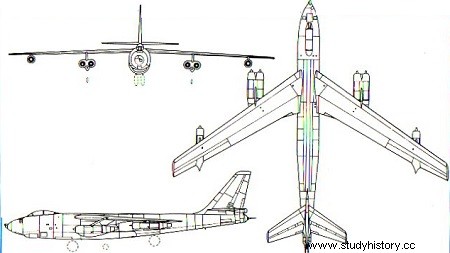
The B-47 Stratojet was the first valuable jet bomber to to enter USAF service and the absolute first in its class to feature swept-back wings. The approximately 1,800 examples from the many versions produced between 1946 and 1957 remained in service with the Strategic Air Command throughout the 1950s and until the mid-1960s, when the United States relegated them to the detachments reserve.
The project that was to give birth to the B-47 was born in the midst of the war, at a time when the main Allied aeronautical factories - driven by the needs of the conflict - were studying the possibilities of jet engine. It experienced many setbacks and forced the Boeing technicians interested in the program to review their designs many times. But, at the end of the war, after the engineers became aware of the studies carried out by the Germans in this field, the United States decided to examine the possibility of adopting positively swept wings. From then on, the work was oriented in this new direction and, in October 1945, the basic project for the new bomber was born. In April of the following year, Boeing completed a preliminary design of the aircraft, and a month later the USAF ordered the construction of two prototypes, called XB-47. The first flew in 1947, on December 17, a historic date since it was the anniversary of the Wright brothers' first flight.
The new aircraft took the form of an elegant high-winged monoplane, fitted with thrusters housed in four nacelles, the inner two of which contained a couple of turbojet engines. The prototype had six Allison J35 turbojet engines of 1,701 kilos of thrust each. The crew sat under a single pressurized drop-shaped fighter-type canopy, while the fuselage accommodated the war load and fuel tanks. After modifying the second prototype by installing J47 engines of 2,265 kilos of thrust, the Boeing received an initial order of 10 copies. Called B-47A, the first of these flew on June 25, 1950 and deliveries to the USAF began six months later.

The first major production version, the B-47B, flew under prototype form on April 26, 1951. It was characterized by certain changes in the structure, by the possibility of placing external auxiliary fuel tanks and by that of being refueled in flight. The technicians also modified the engines and production continued until the completion of the 380th copy. Deliveries to detachments began in the summer of 1951, and soon the B-47s were also equipping American bases in Africa, the Pacific and Great Britain, as part of a large rotation program of different operational units. When the first copies of the next production version, the 8-47E, appeared on January 30, 1953, the Americans transformed 51 B-478s for instruction and 24 for photographic reconnaissance. Equipped with new engines, armament and some new aircraft, the 8-47E became the model produced in the greatest number:the assembly lines of Wichita, Tulsa and Marietta produced 1,359 examples of the bomber, while 255 others RB-47E, intended for photographic reconnaissance, came out of the Wichita factories.
Production ended on February 15, 1957, at a time when the Strategic Air Command was using some 1,800 examples of the bomber in the front line, that is to say a maximum number never reached before. This year 1957 also marked the decline of the Stratojet. In increasing quantities, the B-47s began to be transformed first for reconnaissance (RB-47K, RB-47H) and for instruction (ETB-47E), then served as guided targets (QB- 47). The last examples left the USAF in 1966.
Airplane :Boeing B-47 Stratojet.
Manufacturer :Boeing Airplane Co.
Type: bombardment.
Year :1953.
Engine :six General Electric J47-GE-25 turbojet engines of 2,721 kg thrust each.
Wingspan :35.35 m.
Length :33.47 m.
Height :8.50 m.
Take-off weight :93,759 kg.
Maximum speed :975 km/h at 4,968m altitude.
Maximum operating altitude :12,345 m.
Range :6,435 km.
Armament :2 cannons of 20 mm; 9,072 kg war load.
Equlpage :3 people.
